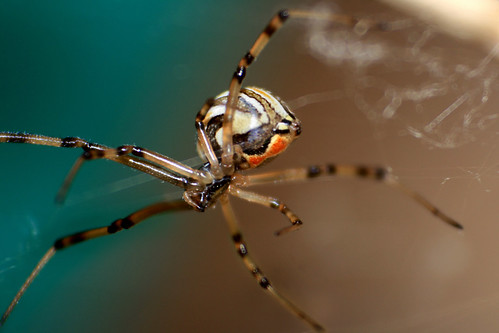 (See Part I here.)
(See Part I here.)I uploaded a picture of a backyard critter to Flickr, named it one thing, and an online viewer said I was wrong; it's a different species. Naturally, the only course of action was to hatch an egg sac of highly venomous spiders to see who was right. So now, I raise black widow spiders.
This hasn't, at any point, seemed like an unusual or ill-advised exercise. It certainly doesn't seem, as my husband has suggested, like an absurdly elaborate effort just to find out if I'm right. Not only because there's no such thing as going to far to prove myself correct (there isn't), but because there's no such thing as pushing the boundaries of empirical investigation too far. There's really no convincing me that any truth, no matter how trivial, is too trivial to pursue. The more atypical, the better.

We've had a cluster (the proper group name for spiders, or, if you like, colony) of black widows living in an old apple juice jug for some time. Much to my husband's dismay, I rescued a slightly squashed egg sac from our garage and stuck it in the jug with a twig. For several months, I've tended the cluster, tossing in crickets every day or so. The tiny, translucent, yellow-white spiders emerged from the sac and quickly formed a messy glistening web in the jug. I'd estimate we started with about fifty spiders, but their numbers began to thin almost immediately. Until very recently, they preferred siblicide as a method of procuring food, no matter how many fat crickets I supplied.
Every week or so, if they've eaten enough, the spiderlings will outgrow and shed their old exoskeletons, leaving the fragile husks behind in the tangled web. They almost have personalities. I've come to identify certain spiders individually. A clear front-runner has emerged, and she (the abdomen is swelling, and her mass and ever-emerging hourglass have me calling it a female) hangs at the top of the communal web, chasing away any passerby. She's given a wide berth. A second female is fairly large, but seems to have molted only three times to the alpha female's four molts. A few smaller females seem to have trouble getting enough food, and have only molted twice that I've witnessed. There is just one that looks male, more spindly than his fat sisters. He is cautious, eating when the other spiders are far away.
All the spiderlings have learned to use the web as a fine-tuned machine. The black widow web is not ugly, not "messy," although that's how it's differentiated from the
 more-popular orb webs. The crisscrossing lines shoot in all directions, forming an efficient three-dimensional detection and pulley system. A hungry spiderling will explore the threads of the web, moving a front leg in clockwise motions until it reaches a foothold, picking carefully along the strands and occasionally plucking at them. When it finds prey, it swiftly reels it up, using its back feet to blanket the insect with web before rushing in to deliver several small bites. It eats from several angles to drain the prey of as much sustenance as possible.
more-popular orb webs. The crisscrossing lines shoot in all directions, forming an efficient three-dimensional detection and pulley system. A hungry spiderling will explore the threads of the web, moving a front leg in clockwise motions until it reaches a foothold, picking carefully along the strands and occasionally plucking at them. When it finds prey, it swiftly reels it up, using its back feet to blanket the insect with web before rushing in to deliver several small bites. It eats from several angles to drain the prey of as much sustenance as possible.I love spiders. Even black widows. Especially black widows. I seriously, abnormally love them. But I think one of the things I love most isn't even exclusive to the black widows themselves. It's the careful investigation they inspire. Even the first encounter with a black widow calls for it -- Does she have the red hourglass? Is it really a black widow? Everything about them begs deeper investigation. Do they really eat their mates? How often? Have you seen it happen? If you're not looking closely, you won't even see their homes, most times. I've found black widows under corners of old playground equipment, in rock crevices, and in piles made beautiful by a glimmering web lacing together a heap of litter in the desert. I'll capture them if they're in dangerous (people-adjacent) areas. It's not hard, and I've never been bitten. Each time, I am certain I was the only one who knew they were there. No one else looks.
Their reputation, as well,
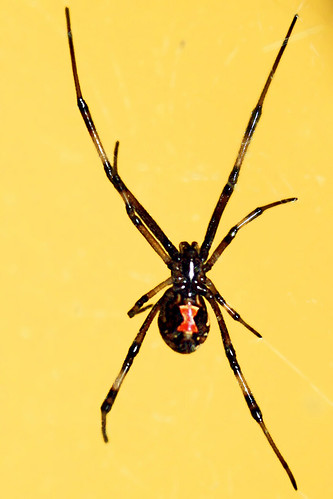 begs for deeper inquiry. Any time anyone says to me; of a phenomenon or creature or, well, anything; "Everyone knows that...," the first thing I do, the very first thing, is attempt to falsify the common wisdom. Nearly the only things most people know about black widows are the "everyone knows" bits. There is much more to the story.
begs for deeper inquiry. Any time anyone says to me; of a phenomenon or creature or, well, anything; "Everyone knows that...," the first thing I do, the very first thing, is attempt to falsify the common wisdom. Nearly the only things most people know about black widows are the "everyone knows" bits. There is much more to the story.I first encountered black widows not in real life, but in fiction, while loitering in the elementary school library, waiting for my dad to write lesson plans and head home. In some obscure, ancient anthology -- sandwiched between stories about a girl's pony and a boy who couldn't read -- was a story about a put-upon misfit who captured a nest of black widows and ground them into paste, intending to bake them in brownies or something and poison his classmates. At least, I think that was the setup. I never read the ending, and even then, I knew it got much wrong. Were there really "nests" of black widows? Where? Did their ability to inject venom mean that you could grind their bodies and use them as poison? Would cooking ruin the poison? Had anyone tried such a thing? Weren't there animals that ate black widows?
"Just make sure you leave them alone," the librarian advised when I asked, before handing me the brand-new Encyclopedia Britanica
 CD-ROM (with a MOVING PICTURE of a volcano!), which had no information about black widows, probably as a distraction. Naturally, I considered her advice, and resolved from that point forward to seek out as many black widow spiders as humanly possible.
CD-ROM (with a MOVING PICTURE of a volcano!), which had no information about black widows, probably as a distraction. Naturally, I considered her advice, and resolved from that point forward to seek out as many black widow spiders as humanly possible.In the meantime I read, and in no time at all I learned enough basic black widow facts to bore my family for years to come. Common wisdom had a few things right, but only just: They may eat their mates, but only sometimes; and their venom can kill humans, but will probably just make them very miserable for a few days. (Small kids, pets, and the elderly are much more vulnerable. I kept our animals at bay and naturally I didn't, as a child, consider myself a child.) I'd be lying if I said the danger element didn't further excite me. I was hooked for life.
The female is the dangerous one. Her venom is supposedly fifteen times more potent than a prairie rattlesnake's, though she injects it in much smaller quantities. A glossy black marble on pointy, sleek, claw-tipped legs, she's most easily identified by the a vivid red hourglass on her underside. She only occasionally eats the male, who cautiously plucks at the web of a potential mate, sort of like a lyre, upon approach. Sometimes, she'll eat him without mating. She can save sperm from a single mating and lay several egg sacs, each with hundreds of eggs. She typically lives up to a year.

Still, at 12, I had seen just one or two in real life. I needed some serious field knowledge. I began to hunt black widows.
That's my problem. Someone says "Don't do X. X is very dangerous," and the first thought in my head is never Gee, maybe I should stay away from X; but rather I bet there's more to it! Imma go check it out right freaking now!
Only I don't think it's a problem at all. Rampant curiosity. It's the antidote to close-mindedness, to intellectual stagnation, and to being too much like all the other kids in the class. It certainly gives an introverted tomboy much with which to occupy her time. Years later, it's made me the coolest mom ever. (To eight-year-old boys, anyway. Sorry, parents.)
As a child, I began to find the occasional black widow. One thing I
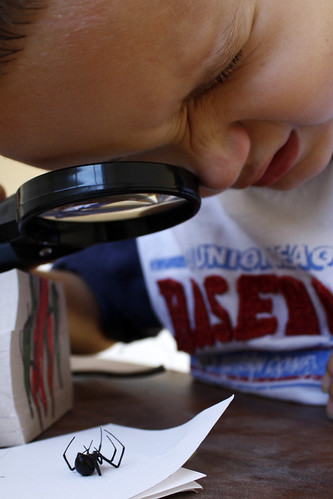 learned that no one wrote about: Sound is the best way to find them. The widows usually build their webs against a hole or shadowed nook and hide, which can make identification difficult. So I would check the web. I'd find a good strong web where a building met the ground, in a pile of debris, under a branch. I'd take a sturdy stick and pull apart a small section of the web. The black widow webs all had a distinctive rip and crackle. You just don't get that from boring old orb weavers. (An easier test: take a broom and sweep gently across the web. If the web doesn't break, you might have a black widow.)
learned that no one wrote about: Sound is the best way to find them. The widows usually build their webs against a hole or shadowed nook and hide, which can make identification difficult. So I would check the web. I'd find a good strong web where a building met the ground, in a pile of debris, under a branch. I'd take a sturdy stick and pull apart a small section of the web. The black widow webs all had a distinctive rip and crackle. You just don't get that from boring old orb weavers. (An easier test: take a broom and sweep gently across the web. If the web doesn't break, you might have a black widow.)Decades later, as a parent, I'm still fascinated. Our group is down to five now (it was six, but I'm pretty sure the smallest one was just wrapped up by the large female). They seem to have staked out their own "territories" -- the alpha and beta females near the lid, nearly always hanging upside down, the spindly male on the opposite end, and the two smaller ones foraging among the cricket husks or hanging a small distance from the male.
My son helps me feed them. We take them out each day, watch them in the sunlight, before he places their home gingerly back in the dark. He's cautious, but not scared. He's in love with black widows. He has questions now to which I have no answers. Questions I'd never considered. I am exceedingly proud.
I'd say "My work here is done," but you know it isn't.
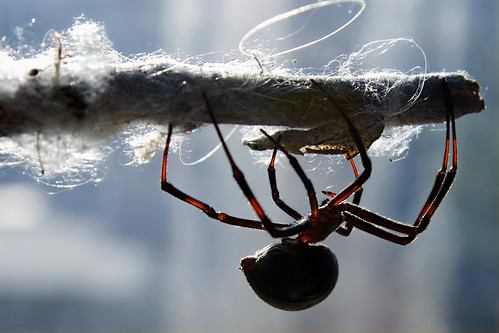
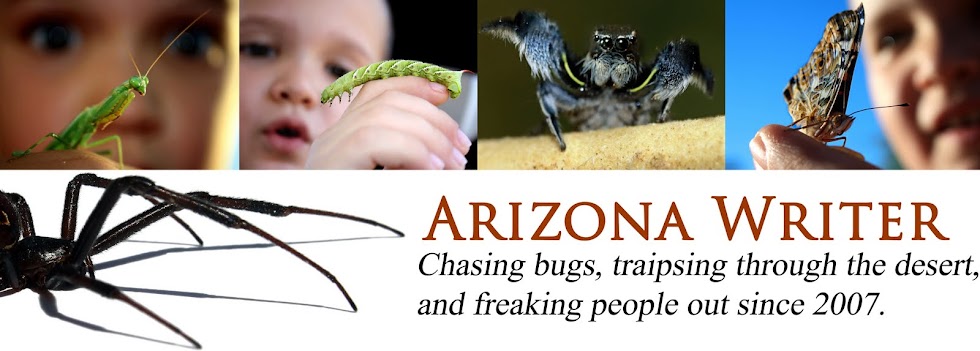
6 comments:
Oh wow! I love this. I'm more of an insect girl than a spider girl, but still this is fascinating.
I'm both! I seriously have a hard time deciding if I love black widows or mantises more. (I guess most people never have such a debate with themselves.)
And thanks.
Hi - thanks for the comment on my blog - seems that spiders are a bit of a theme!
Had not had the chance to take any good iamges of Red Backed Spiders but we get them in my garden - and often in the compost bin!
They still wierd me out, but I cant keep myself from looking!!
Cheers Stewart M
I am glad that someone can appreciate the fierce beauty of these poisonous critters. That person is not me, but I am glad someone can. You can have all the black widows breeding in my yard. Would you like to take the roaches that swarm upon my home every spring as well?
Thanks, Stewart. I love redbacks, though we have their cousins here. So striking!
Thanks but no thanks, Carolyn. :-) I think we've got all the insects we need, probably. Just think, maybe the black widows will take care of your roaches!
Love the history here Kim. I also love that your little man has questions you had never considered. That is one of my favorite things about being a mom... when that happens.
Awesome post!!
Spectacular pictures as usual!
Post a Comment